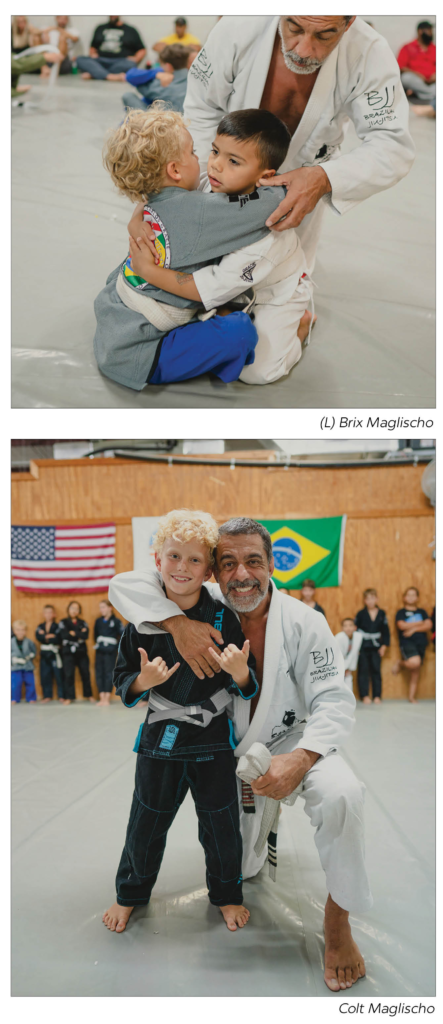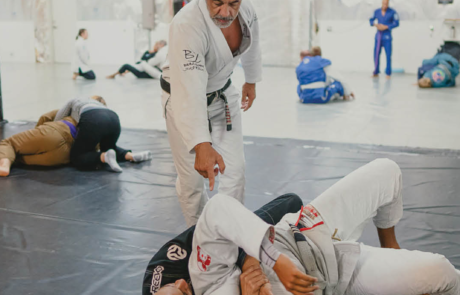By Rebecca Maglischo
Photographer Jerry Eang
The man at the front of the room says a few funny comments and then calls my husband’s name in a thick Brazilian accent, “Mark!” Amidst the clapping, a few whistles and a lot of pats on the back, Mark walks to the front of the room. No one else would notice, but I see the slight swell of my husband’s chest. Pride. This is the most humble man I know and a little pride looks good on him. The instructor, Fabio Novaes, removes the white belt from around my husband’s waist and replaces it with a blue one. Then, just as importantly, he wraps Mark in a hug and congratulates him. This has not been an easy road, but nothing about Brazilian jiu-jitsu could be described as easy.
A quick glance at Wikipedia will tell you, “Brazilian jiu-jitsu, BJJ, is a self-defense martial art and combat sport based on grappling, ground fighting, and submission holds. BJJ approaches self-defense by emphasizing taking an opponent to the ground, gaining a dominant position, and using a number of techniques to force them into submission via joint locks or chokeholds. Brazilian jiu-jitsu was initially developed in 1925 by Brazilian brothers Carlos, Oswaldo, Gastão Jr., O’Brien, and Hélio Gracie, after Carlos was taught jiu-jitsu by a traveling Japanese judoka, Mitsuyo Maeda, in 1917. Later on, the Gracie family developed their own self-defense system, and published Gracie Jiu-Jitsu. BJJ eventually came to be its own defined combat sport through the innovations, practices, and adaptation of Gracie jiu-jitsu and judo, and became an essential martial art for modern MMA. This seems to be a good summary of the sport. But for so many people, jiu-jitsu is so much more.
From the corner of my eye, I see two blonde, curly heads peek through the doorway and weave their way to a good viewing position. My sons. They know the significance of this moment because they practice jiu-jitsu, too. Mark and I married late, and, under the pressure of time, quickly had two children back to back. We ran a gym, worked long hours, and I have no doubt he often wondered why in the world he left his calm bachelor life for all this chaos. I teased him, maybe a bit too much, when he decided to visit Fabio Novaes Brazilian Jiu-Jitsu. He told me later he almost didn’t return after the first day. It was hard… and frustrating… and overwhelming… and it exposed every weakness, physically and emotionally. He feared my eye rolling and “I told you so” even more.



Fabio Novaes and Roberta Capeluto are the owners of Fabio Novaes Brazilian Jiu-Jitsu in Lakeland, Florida. Fabio started training Brazilian jiu-jitsu in 1992. Ten years later, he was awarded his black belt by instructor Marcelo Saporito, head instructor of Carlson Gracie School in Copacabana, Rio de Janeiro, Brazil. Fabio is recognized by the Brazilian Jiu-Jitsu Confederation, (Confederacao Brasileira de Jiu-Jitsu – CBJJ), The Rio de Janeiro Jiu-Jitsu Federation (Federacao de Jiu-Jitsu do Rio de Janeiro – F.J-J.RIO), The Olympic Jiu-Jitsu Federation of Rio de Janeiro (Federacao Olimpica de Jiu-Jitsu do Estado do Rio de Janeiro – FJJORJ) and the Brazilian Confederation of Olympic Jiu-Jitsu (Conferacao Brasileira de Jiu-Jitsu Olimpico – CBJJO). Fabio is a two time Gi Pan Am champion and a No-Gi champion. His hard work and dedication to the sport of jiu-jitsu has placed him on the podium in the most important BJJ competitions in the world. This list of accomplishments might bring people in the doors of the jiu-jitsu school; it is something entirely different, however, that keeps them coming back.
Two months into my husband’s jiu-jitsu journey, I told him he couldn’t quit. We’d make every accommodation as a family to honor and support that time for him. The changes in Mark were incredible. The frustration that hung just under the surface of his demeanor began to settle. He had an outlet, a healthy way to vent, and a new challenge for his mind as he worked to grasp the chess game of grappling. Soon, I caught him playing jiu-jitsu games with the boys, wrestling with them and teaching them little basics.
My husband had a way to engage with my children, a new language that they could share when words just wouldn’t fix the problem. And as soon as the boys were old enough, they joined Mark on the mats. In the beginning, my oldest struggled. Naturally athletic and admirably strong-willed, he pushed hard against the inevitable humility that comes with jiu-jitsu. My youngest, much more complacent and tender than his brother, found himself overwhelmed in difficult physical situations. The emotions were intense. Each time things got tough, Mark pulled the boys out onto the garage mats. “Let’s drill a bit, maybe we can roll around and figure it out together…”
The door of the Fabio Novaes Brazilian Jiu-Jitsu School reads “When you step on my mats, leave your pride outside.” This is undoubtedly the first step of Brazilian jiu-jitsu. “You will not survive if your ego is in the way,” says Roberta Capuleto, Fabio’s wife and a brown belt in jiu jitsu. “You will not persevere because you will not be open to learning. Brazilian jiu-jitsu teaches you to remain calm under pressure and to think before making a move. You learn more about your own body and become equipped to face fears and overcome frustrations.” Fabio and Roberta have lived these principles on and off the mats.
A young couple struggling with limited opportunities in Brazil, the two set out on the adventure of a lifetime. They moved to America. It took some hard knocks, serious determination, and a lot of work before they landed in Lakeland and decided to open a jiu-jitsu school. The school, which now also has a Brandon location, has thrived because every student that hangs in there becomes like family.


My husband asked repeatedly for me to come try a class with him. He opened the door to his little world and invited me in. It took me over a year to finally take him up on the offer. He knew what I didn’t… I needed this. I had lost myself in child rearing. I had also closed the doors of my gym in the wake of the pandemic. I was angry at life and fumbling to figure out what was next. My pull-up-your- bootstraps attitude didn’t work in jiu-jitsu, and after every class, I sat in my minivan and cried. Decades of angry frustration poured out of me. Then I’d go home, shower, and show up again.
Fabio calls my name next. He replaces my white belt with a blue one and hugs me. “The Tasmanian Devil,” he says with a smile. That’s what he calls me. Each person in the room comes through the line to hug and congratulate my husband and me. They all know. They are either on the journey to this point or well beyond us on the road. The people in this room are so different from one another. They have shared sweat and occasionally, a little blood. They have been humbled and they have done the humbling. We all know how it feels. We all have immense respect for one another just because we keep showing up to do the hard thing. There is not a person in the room that has not considered quitting jiu-jitsu, and some here have considered quitting life. Fabio likes to say “We’re all the same, the white belt and the black belt. The black belt just has more experience. But we are all still learning. We are all still pushing and we need each other to push against.” When the last person passes through the line, my husband turns to me for a hug. My kids run in and wrap their little arms around our legs. We’re still learning, too, together, as a family.










